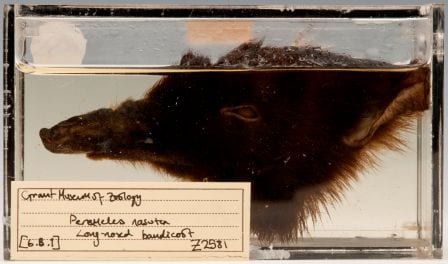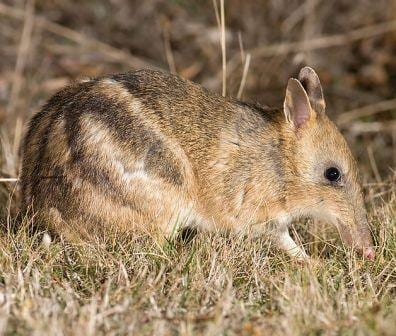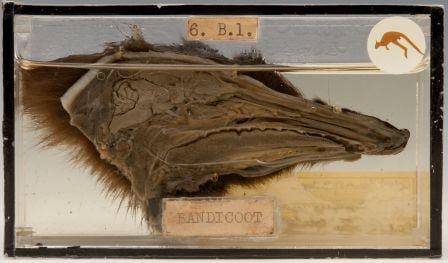Specimen of the Week: Week 118
By Emma-Louise Nicholls, on 13 January 2014
 This is the 500th post on the Museums and Collections blog! That is a lot of information we have researched, written and sent out into the ether for your pleasure. I hope you appreciate our efforts? Cropping up in many of the blogs by the Grant Museum is the jar of moles, who’s celebrity status is undeniable. It sits in full view of the adoring public as they rush through the door, having queued up outside the Museum waiting for us to open, in order to catch a glimpse of the sacred specimen. Hordes of people can be heard talking about it on a daily basis, and an internet search for ‘jar of moles’ brings up several pages referencing the Museum and our specimen. However last week, a lady came to speak to me at the Museum and said with an uneasy smile “That jar of moles is the most disgusting thing I’ve ever seen, it makes me feel sick”. At first I thought Clearly you haven’t seen the Surinam toad but then I thought Hah! How rare it is to have someone disapprove of this really quite bizarre spectacle of a specimen. How lovely! It got me thinking what else might be perceived as disgusting and as such, I arrived at this week’s Specimen of the Week is…
This is the 500th post on the Museums and Collections blog! That is a lot of information we have researched, written and sent out into the ether for your pleasure. I hope you appreciate our efforts? Cropping up in many of the blogs by the Grant Museum is the jar of moles, who’s celebrity status is undeniable. It sits in full view of the adoring public as they rush through the door, having queued up outside the Museum waiting for us to open, in order to catch a glimpse of the sacred specimen. Hordes of people can be heard talking about it on a daily basis, and an internet search for ‘jar of moles’ brings up several pages referencing the Museum and our specimen. However last week, a lady came to speak to me at the Museum and said with an uneasy smile “That jar of moles is the most disgusting thing I’ve ever seen, it makes me feel sick”. At first I thought Clearly you haven’t seen the Surinam toad but then I thought Hah! How rare it is to have someone disapprove of this really quite bizarre spectacle of a specimen. How lovely! It got me thinking what else might be perceived as disgusting and as such, I arrived at this week’s Specimen of the Week is…
**The long-nosed bandicoot**

The one remaining fluffy side of the head of our
long-nosed bandicoot (Perameles nasuta)
LDUCZ-Z2581
1) I would say you may be forgiven for thinking you had stumbled across a very large rat with an oversized head when you see your first long-nosed bandicoot in the rainforests or woodlands of Australia. However, I have been assured by my manager who’s field of expertise is Australian marsupials, that these half metre mammals bound/hop about and behave in such a way that they could not be mistaken for rats should you ever see a live one. As he’s been up close and personal with them in the wild, I shall take his word for it. So whilst they are definitely not rats, the familial relationships of bandicoots are otherwise rather enigmatic. I like a mystery though, so that puts bandicoots up there on my list of cool animals. Until someone works it out, then they’ll probably be relegated.
2) Ok, ok, I’m grossly underselling the bandicoot, and besides, there are always exceptions to every rule and this particular species of bandicoot will always be cool. But I shall try harder to sell the regular kind…
The long-nosed bandicoots is a super exciting animal that is so much more than a large, fuzzy, long-nosed, shortish-tailed rat. The long-nosed bandicoot’s fur is a delightful shade of grey, which blends into the vibrant cream coloured fur of the belly area and feet. Some bandicoot species make more effort than others in their appearance, incorporating both grey and brown into their fur and bringing the two colours stylishly together in pseudo stripes along the animals’ flanks, as shown in the image below. But not the long-nosed bandicoot.

The beautiful eastern barred bandicoot. (Image
taken by J. J. Harrison. Obtained from
commons.wikimedia.org)
3) The time taken between meeting ‘the one’ and the normal biological response to that taking place, to production of offspring is just 12.5 days. Marsupials tend to have a shorter gestation period than placental mammals as the babies continue to develop ‘externally’, in the pouch. This pouch is most obvious on animals like kangaroos. The long-nosed bandicoot will have between one and five young in a single litter, although the normal number is two or three. It takes just two months for baby bandicoots to get bored of mother’s milk and once the litter has been weaned, the female often has another litter within just a few days. Sounds like the Queen in Alien. As is common in digging marsupials, the female’s pouch opens towards the rear, to prevent dirt from clogging it up and doing harm to the babies inside.
4) The long-nosed bandicoot is a solitary animal that normally spends the day tucked up in its nest, which comprises a small hole excavated in the ground and lined with vegetation. A curious little creature to watch, the long-nosed bandicoot spends its nights apparently frantically running about, stopping every now and then to forage by digging with its forepaws and then inserting its Pinocchio-esque nose into the hole to see what insects it can hoover up. It will also eat worms, lizards, mice and some plant types.
5) The (potentially) disgusting element of this specimen is that is has been cut in half. The inside of the head is carefully preserved to show the internal structure and serves to emphasise the elongate morphology of the nose. This specimen was actually prepared by Victor Negus who was, in his time, a pioneering laryngologist. Hence his fascination with cutting heads in half.
Emma-Louise Nicholls is the Curatorial Assistant at the Grant Museum of Zoology
 Close
Close


